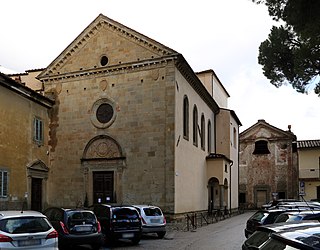
The Chiesa di San Giacomo dall'Orio is a church located in the sestiere (quarter) of Santa Croce in Venice, northern Italy.

The Tempio della Beata Vergine della Ghiara, also known as Basilica della Madonna della Ghiara, is a church in Reggio Emilia, northern Italy. The building is the property of the comune (municipality) of the city.

The Basilica della Santissima Annunziata del Vastato is the Catholic cathedral of Genoa, northern Italy; its decoration employed the major baroque studios and artists in Genoa in the 17th century.

Angelo Trevisani was an Italian painter of the late-Baroque, active mainly in Venice.

The Basilica of Saint Nicholas of Tolentino is a Roman Catholic church and minor basilica that is part of the Augustinian monastery in the hill-town of Tolentino, province of Macerata, Marche, central Italy. The church is a former cathedral of the Roman Catholic Diocese of Tolentino, suppressed in 1586.

San Francesco della Vigna is a Roman Catholic church in the Sestiere of Castello in Venice, northern Italy.

San Bernardino is a church in Verona, northern Italy. The church, in Gothic style, was built from 1451 to 1466.

The Basilica of Our Lady of Humility or Madonna dell'Umiltà is a Renaissance-style, Roman Catholic Marian basilica in Pistoia, region of Tuscany, Italy.

The Abbey of Santa Giustina is a 10th-century Benedictine abbey complex located in front of the Prato della Valle in central Padua, region of Veneto, Italy. Adjacent to the former monastery is the basilica church of Santa Giustina, initially built in the 6th century, but whose present form derives from a 17th-century reconstruction.

San Procolo is an early Gothic-style, Roman Catholic church and former monastery-hospital located on Via Massimo D'Azeglio #52 in central Bologna, region of Emilia Romagna, Italy.

Santissimo Salvatore is a Baroque-style Roman Catholic church in central Bologna, Emilia-Romagna, Italy.

Volterra Cathedral is a Roman Catholic cathedral in Volterra, Italy, dedicated to the Assumption of the Virgin Mary. It is the seat of the bishop of Volterra.

The church of Santa Maria delle Grazie in Brescia is located on at the west end of Via Elia Capriolo, where it intersects with the Via delle Grazie. Built in the 16th century and remodeled in the 17th century, it still retains much of its artwork by major regional artists, including one of its three canvases by Moretto. The other two are now held at the Pinacoteca Tosio Martinengo. The interior is richly decorated in Baroque fashion. Adjacent to the church is the Sanctuary of Santa Maria delle Grazie, a neo-gothic work.

The Sanctuary of Madonna dei Miracoli is a church in Alcamo, province of Trapani, Sicily, southern Italy; it is dedicated to the Madonna of the Miracles.
Madonna della Colonnella also known as the Santa Maria Annunziata alla Colonnella is a Renaissance-style Roman Catholic church located in Via Flaminia #96 in Rimini, region of Emilia-Romagna, Italy.

Santa Caterina d'Alessandria or Saint Catherine of Alexandria is a Roman Catholic church with a main facade on Piazza Bellini, and a lateral Western facade facing the elaborate Fontana Pretoria, in the historic quarter of Kalsa in the city of Palermo, region of Sicily, Italy. In front of the main facade, across the piazza Bellini, rise the older churches of San Cataldo and Santa Maria dell'Ammiraglio, while across Piazza Pretoria is the Theatine church of San Giuseppe and the entrance to the Quattro Canti. Refurbished over the centuries, the church retains elements and decorations from the Renaissance, Baroque, and late-Baroque (Rococo) eras. This church is distinct from the Oratorio di Santa Caterina found in the Olivella neighborhood.

The Madonna Addolorata al Torresino, also called the Santa Maria del Pianto or Santa Maria del Torresino is a Roman Catholic parish church located in the city of Padua, region of Veneto, Italy.

Fossombrone Cathedral is a Roman Catholic cathedral dedicated to Saint Aldebrandus and Saint Augustine located in the Piazza Mazzini at the end of Corso Garibaldi in the center of the town of Fossombrone in the province of Pesaro and Urbino in the region of Marche, Italy. Formerly the cathedral of the Diocese of Fossombrone, since 1986 it has been a co-cathedral of the Diocese of Fano-Fossombrone-Cagli-Pergola.

The Sanctuary of Madonna of Miracles is a Roman Catholic Marian sanctuary located in Corbetta, province of Milan, Lombardy, Italy. The sanctuary is dedicated to the Madonna of the Miracles, whose miraculous frescoed image, known as Madonna di Corbetta, was declared in 1955 to be the patron of the Magentino area in 1955 by the then archbishop of Milan and future pope Paul VI.

Santa Maria delle Grazie, also known as Madonna del Letto, is a Renaissance-style, Roman Catholic church located near the city center in Pistoia, region of Tuscany, Italy.



















